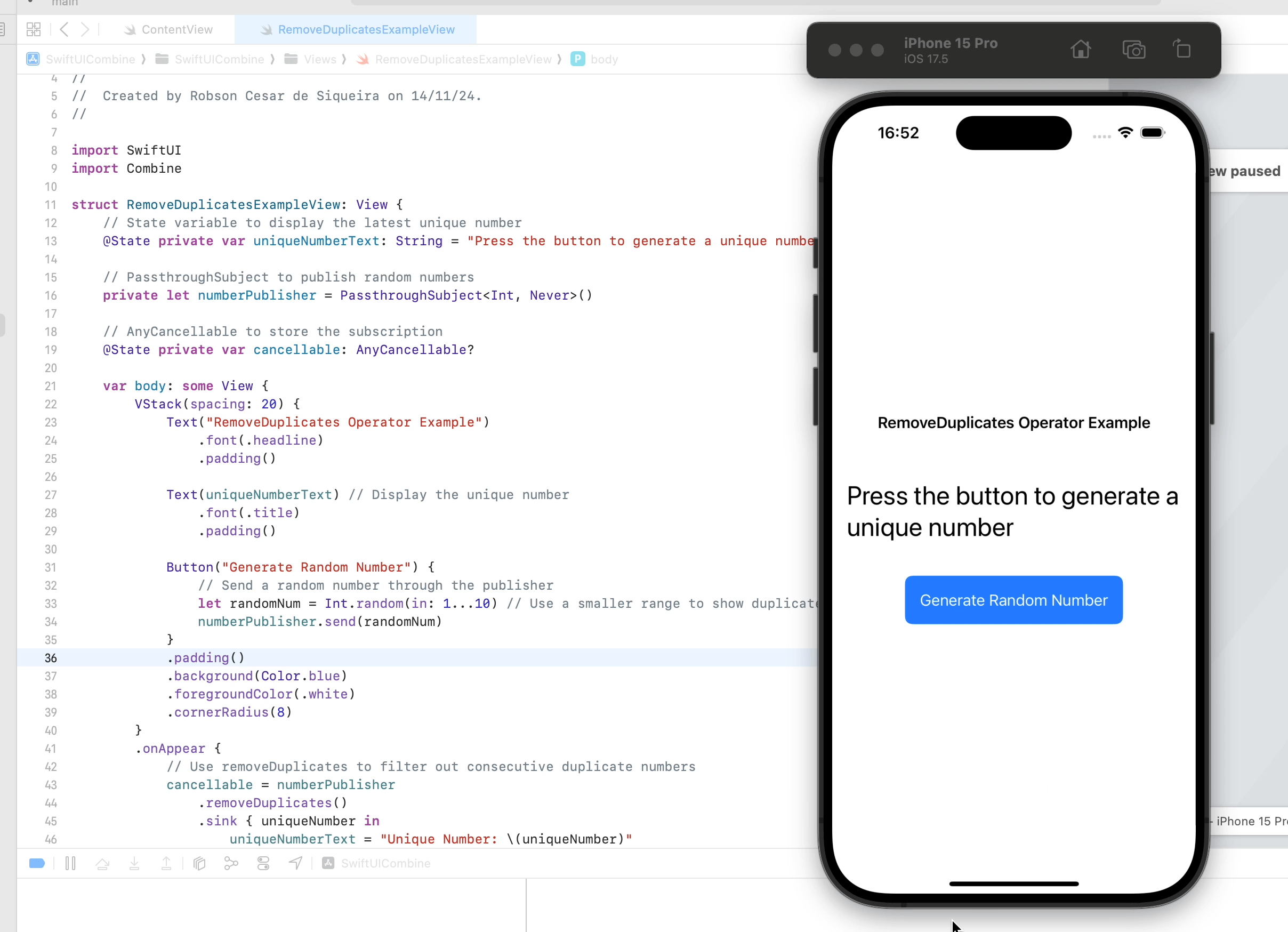In Combine, the removeDuplicates operator allows you to filter out consecutive duplicate values from a data stream. This is particularly useful in reactive programming when you want to ignore redundant data and ensure your SwiftUI views only update when new, unique values are emitted.
What is the removeDuplicates Operator?
The removeDuplicates operator in Combine checks each value emitted by a publisher. If the new value is the same as the previously emitted value, removeDuplicates filters it out and prevents it from being sent down the data stream. This helps reduce unnecessary updates and can improve performance in data flows with frequent repeated values.
For example, you might use removeDuplicates to:
- Ignore consecutive, identical search queries.
- Prevent UI updates when the same state is emitted repeatedly.
- Optimize data streams where duplicate values are common.
In this article, we’ll create a SwiftUI view that uses removeDuplicates to filter consecutive identical numbers from a random number generator, only displaying each unique number.
Example SwiftUI View with removeDuplicates
Below is a SwiftUI view that uses a PassthroughSubject to emit random numbers. The removeDuplicates operator filters out consecutive duplicates, ensuring that only unique values are displayed in the view.
import SwiftUI
import Combine
struct RemoveDuplicatesExampleView: View {
// State variable to display the latest unique number
@State private var uniqueNumberText: String = "Press the button to generate a unique number"
// PassthroughSubject to publish random numbers
private let numberPublisher = PassthroughSubject<Int, Never>()
// AnyCancellable to store the subscription
@State private var cancellable: AnyCancellable?
var body: some View {
VStack(spacing: 20) {
Text("RemoveDuplicates Operator Example")
.font(.headline)
.padding()
Text(uniqueNumberText) // Display the unique number
.font(.title)
.padding()
Button("Generate Random Number") {
// Send a random number through the publisher
let randomNum = Int.random(in: 1...10) // Use a smaller range to show duplicates more often
numberPublisher.send(randomNum)
}
.padding()
.background(Color.blue)
.foregroundColor(.white)
.cornerRadius(8)
}
.onAppear {
// Use removeDuplicates to filter out consecutive duplicate numbers
cancellable = numberPublisher
.removeDuplicates()
.sink { uniqueNumber in
uniqueNumberText = "Unique Number: \(uniqueNumber)"
}
}
.onDisappear {
// Cancel the subscription when the view disappears
cancellable?.cancel()
}
}
}
struct RemoveDuplicatesExampleView_Previews: PreviewProvider {
static var previews: some View {
RemoveDuplicatesExampleView()
}
}
Explanation of the Code
- State Variable:
@State private var uniqueNumberText: Holds the latest unique number that meets theremoveDuplicatescondition. This variable updates only when a new, non-duplicate value is emitted by the publisher.
- PassthroughSubject:
private let numberPublisher = PassthroughSubject<Int, Never>(): This publisher emits random numbers when the button is pressed.
- Button to Generate a New Number:
- The Generate Random Number button generates a random number between 1 and 10 and sends it through
numberPublisher. This small range increases the chance of consecutive duplicates, demonstrating howremoveDuplicatesfilters them out.
- The Generate Random Number button generates a random number between 1 and 10 and sends it through
- The
removeDuplicatesOperator:- Inside
.onAppear, we useremoveDuplicatesonnumberPublisherto ensure that only unique, consecutive numbers pass through. WhennumberPublisheremits a number that differs from the last emitted value,removeDuplicatesallows it to be sent to the downstream subscriber. - Only unique values are captured by
.sink, which updatesuniqueNumberTextwith the latest unique number, causing SwiftUI to refresh the view.
- Inside
- Cleaning Up the Subscription:
- The
.onDisappearmodifier cancels the subscription when the view disappears, preventing memory leaks and stopping updates when the view is off-screen.
- The
How removeDuplicates Helps in SwiftUI
In this example, removeDuplicates reduces unnecessary updates by filtering out consecutive identical values. This approach is useful for optimizing reactive data flows, where repeated values might cause redundant UI updates. By using removeDuplicates, you can ensure that only meaningful changes trigger responses, leading to cleaner, more efficient views in SwiftUI.
Summary
The removeDuplicates operator is a practical tool in Combine for filtering out consecutive duplicates, allowing you to focus on unique changes in your data stream. Whether you’re handling user input, state changes, or sensor data, removeDuplicates ensures that only distinct, consecutive values pass through, reducing clutter and enhancing performance. This is especially helpful in SwiftUI, where minimizing unnecessary updates leads to a smoother user experience.
